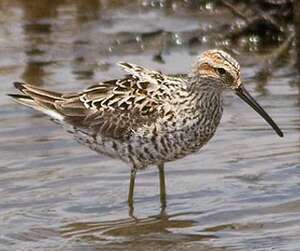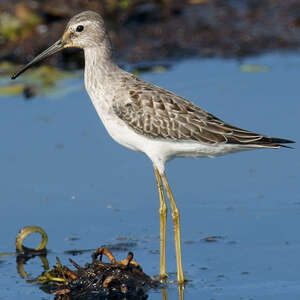Stilt Sandpiper
Calidris himantopus - Bécasseau à échasses
Identification
Stilt Sandpiper with long legs. In breeding plumage, it is a nearly black bird above and strongly barred underneath with black. The legs are greenish, the bill is black and quite long, slightly curved. In winter plumage, the upper parts are greyish, the feathers finely edged in white; the neck, chest and flanks are streaked, neck and chest being a tawny colour while the flanks are white. The young are dark above with a contrast between the tip (blackish) and the base (brown) of the cover and scapular feathers. Neck, chest and flanks are similar to those of adults in winter. At any age, this species has a long white eyebrow line. The Stilt Sandpiper can be distinguished from other species of the genus Calidris by its long, usually pale legs.
Subspecific information monotypic species
Foreign names
- Bécasseau à échasses,
- Correlimos zancolín,
- pilrito-pernilongo,
- Bindenstrandläufer,
- töcspartfutó,
- Steltstrandloper,
- Piro piro zampelunghe,
- styltsnäppa,
- Styltesnipe,
- pobrežník dlhonohý,
- jespák dlouhonohý,
- Klireryle,
- pitkäkoipisirri,
- territ camallarg,
- Vaðfæla,
- biegus brodźcowaty,
- garstilbu šņibītis,
- dulnik,
- Ходулочниковый песочник,
- アシナガシギ,
- 高跷鹬,
- styltsnäppa,
- 高蹺濱鷸,
Habitat
Breeding grounds are found in vast marshes, wet tundra beyond the tree-line, sometimes with a few isolated pine trees.
In coastal areas, it occupies shallow lagoons and brackish grass marshes, rarely sea lagoons.
Behaviour character trait
This species is entirely migratory. Movements occur across North America rather than along coasts. The first departures involve failed breeders and start by the end of June.
Females that have successfully nested start leaving in the first half of July, followed by adult males in the second half, and then by juveniles until the beginning of September. The first arrivals in South America are reported in the very first days of August.In spring, the first arrivals are noted early March in Texas, but only at the end of May or beginning of June on breeding sites. These movements are made in groups up to several tens of individuals. They are made in stages of several hundred kilometers which require non-stop flights, both during the day and at night.
They are also good swimmers in calm waters, including chicks, but this Stilt Sandpiper has never been observed swimming underwater.
Dietfeeding habits
The Stilt Sandpiper looks for food in the water up to its shank or in the silt. In breeding season, it also feeds on dry ground in the tundra. Its diet varies greatly according to the seasons. In breeding season, it is 90% composed of invertebrates (adult coleoptera, various larvae, small snails, adult diptera). It is capable of capturing small frogs. During migration, seeds can make up an important contribution (up to 30%).
Reproduction nesting
Males establish a territory as soon as they arrive at the breeding sites and defend it. If both members of the pair survive, they come back to the same territory and usually do not perform any nuptial parade.
The formation of new couples is accompanied by long aerial parades. There is only one clutch per year, as time is of the essence at these latitudes! It is the male that chooses the breeding site and the female that prepares the actual nest. The nest is a small depression dug into the ground by the male with its breast and lined with vegetable debris by the female. Laying usually begins in the first half of June. Nearly all clutches have four eggs. Both sexes incubate for about 20 days, the males during the day and the females at night. Most females then leave, while the chicks (fledged) are only 2 or 3 days old, while the males when they are between 10 and 14 days old, well before they are able to fly!Geographic range
This Stilt Sandpiper only nests in subarctic regions of North America from James Bay to northern Alaska. It winters mostly in interior South America, from Bolivia to the Buenos Aires area. A few individuals winter in the southern United States (California, Texas, and Louisiana) as well as in some sites in Central America. Rare individuals have been observed in Europe and Australia, Japan, and Taiwan. It has been observed seven times in France (up to 2002), between 23rd July and 11th October, all along western coasts between Ouessant and the Gironde.
Threats - protection
IUCN conservation status
concern
in the Wild
threatened
evaluated
The species does not appear to be threatened. However, Canadian researchers have noted a decline in reproductive success since the 1960s (91% of the nests had at least one hatched egg compared to only 68% between 1992 and 1996). This is probably due to degradation of habitat consequent to overgrazing by Canadian geese or snow geese. During their movements, electrical wires constitute formidable obstacles.
Sources of information
- IOC World Bird List (v15.1), Gill, F and D Donsker (Eds). 2025-12-07.
- Field Guide to the Birds of North America, National Geographic Society
- Guide des limicoles d'Europe, d'Asie et d'Amérique du Nord, D. Taylor
- Le guide ornitho : Le guide le plus complet des oiseaux d'Europe, d'Afrique du Nord et du Moyen-Orient : 900 espèces, Svensson, Mullarney, Zetterstrom
- Shorebirds, an identification guide to the waders of the world, Peter Hayman, John Marchant Tony Prater
- The North American Bird Guide, David Sibley
- The Field Guide to the Birds of Australia, Graham Pizzey et Frank Knight
- Vol. 3 - Handbook of the Birds of the World, Josep del Hoyo-Andrew Elliott-Jordi Sargatal
- Waterbird Population Estimates, Simon Delany Derek Scott
- Avibase, Lepage Denis
- The Birds of North America,
- Nouvel inventaire des oiseaux de France, Philippe J. Dubois, Pierre Le Maréchal, Georges Olioso, Pierre Yésou
- Limicoles, gangas et pigeons d'Europe, Paul Géroudet (mise à jour Georges Olioso)
Other sources of interest
 Specification sheet created on
30/07/2023 by Georges Olioso
Specification sheet created on
30/07/2023 by Georges OliosoTranslation by AI Oiseaux.net
© 1996-2026 Oiseaux.net
- Accipitriformes
- Aegotheliformes
- Anseriformes
- Apodiformes
- Apterygiformes
- Bucerotiformes
- Caprimulgiformes
- Cariamiformes
- Casuariiformes
- Charadriiformes
- Ciconiiformes
- Coliiformes
- Columbiformes
- Coraciiformes
- Cuculiformes
- Eurypygiformes
- Falconiformes
- Galliformes
- Gaviiformes
- Gruiformes
- Leptosomiformes
- Mesitornithiformes
- Musophagiformes
- Nyctibiiformes
- Opisthocomiformes
- Otidiformes
- Passeriformes
- Pelecaniformes
- Phaethontiformes
- Phoenicopteriformes
- Piciformes
- Podargiformes
- Podicipediformes
- Procellariiformes
- Psittaciformes
- Pterocliformes
- Rheiformes
- Sphenisciformes
- Steatornithiformes
- Strigiformes
- Struthioniformes
- Suliformes
- Tinamiformes
- Trogoniformes



























